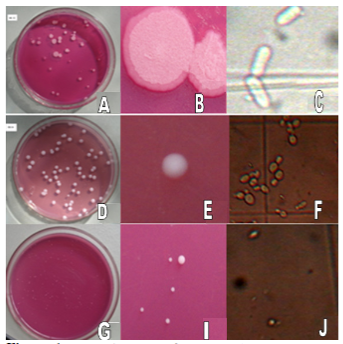Cepas selvagens de levedura de fermentação isoladas de suco de cana-de-açúcar de uma destilaria de álcool de Mato Grosso, Brasil
DOI:
https://doi.org/10.20873/jbb.uft.cemaf.v2n3.silvaPalavras-chave:
Isolamento, morfologia, bioprospecção, biodiversidade, fermentaçãoResumo
A produção de etanol é importante para a economia nacional constituindo-se em solução renovável para complementar derivados de petróleo. O processo industrial utiliza leveduras disponíveis comercialmente, a maioria das quais isoladas em usinas do estado de S. Paulo. Não se têm conhecimento sobre a disponibilidade de leveduras selecionadas para as condições climáticas da região Centro Oeste. O artigo apresenta os resultados do isolamento e caracterização morfológica de levedurasselvagens fermentativas obtidas do caldo de cana da usina do município de Barra do Bugres, Mato Grosso. As amostras de caldo foram coletadas na época quente e chuvosa e na fria e seca da mesma safra. Foram semeadas em agar LWYN e avaliadas para fermentação em tubos de ensaio contendo tubos de Durhan invertidos. Apenas aquelas com habilidade para fermentar percebidas pela presença de bolhas de gás foram caracterizadas. Maior número e diversidade de leveduras foram obtidas nos meses de dezembro e julho, mas, apenas as condições climáticas não explicaram esses resultados. Concluiu-se que o caldo de cana é uma boa fonte para biodiversidade em leveduras.
Referências
Andrietta, S. R.; Andrietta, M. G. S.; Rodrigues, M. I. (1995), Método de caracterização de leveduras de processo utilizando parâmetros cinéticos e produção específica. Stab/Açúcar, Álcool e Subprodutos, 4, 22-25.
APHA, American Public Health Association. (2001), Compendium of methods for the microbiological examination of foods. 4.ed. Washington, 64p.
Borba, C. M. and Rodrigues, K. F. (2000), Viability and sporulating capability of Coelomycetes preserved under a range of different storage regimes. Revista Iberoamericana de Micología, 17, 142-145.
Cabrini, K. T. and Gallo, C. R. (1999), Identificação de leveduras no processo industrial de fermentação alcoólica em usina do Estado de São Paulo, Brasil. Scientia Agricola, 1, 207-216.
Ceccato- Antonini, S. R.; Tosta, C. D.; Silva, A. C. (2004), Determination of yeast killer activity in fermenting sugarcane juice using selected ethanol-making strains. Brazilian Archives of Biology and Technology, 1, 13-23.
Ceccato-Antonini, S. R. (2010), Microbiologia da fermentação alcoólica. A importância do monitoramento microbiológico em destilarias. São Carlos: EduFSCar, 1, 105p.
Cid, V. J.; Sanchez, M.; Nombela, C. (1994), Characterization of thermosensitive autolytic mutants from diploid, Saccharomyces cerevisiae. Microbiology, 140, 559-68.
Costa, C. P.; Ferreira, M. C. (1991), Preservação de micro-organismos. Revista de Microbiologia, 3, 263-268.
Dorneles, D.; Machado, I. M. P.; Chociai, M. B.; Bonfim, T. M. B. (2005), Influence of the use of selected and non-selected yeasts in red wine production. Brazilian Archives of Biology and Technology. 48, 747-751.
Fermentec News, Disponível em: <http://www.fermentec.com.br/br/news/Ferment ec%20News%2002%20%202005.pdf> acesso em 28/01/2010.
Pataro, C.; Guerra, J. B.; Petrilho, P. M. L, Mendonça, H. Lc, Linardi, V. R.; Rosa, C. A. (2000), Yeast communities and genetic polymorphism of Saccharomyces cerevisiae strains associated with artisanal fermentation in Brazil. Journal of Applied Microbiology, 1, 24- 31.
Parrazi, C. and Oliveira, M. C. F. L. (1996), Comparação de linhagens de leveduras Saccharomyces cerevisiae floculantes em processo descontínuo de produção de álcool e aguardente In: Congresso Nacional da Stab, Anais, 1, 121-129.
Pelczar Jr, M. J.; Chan,E. C. S.; Krieg, N. R. (1996), Microbiologia: conceitos e aplicações. 2 ed. São Paulo: Makron Books do Brasil. 1, 524p.
Silva Filho, E. A. Caracterização genética de populações de leveduras de destilarias de álcool combustível para otimização do processo de fermentação. Tese (Doutorado em Biologia de Fungos) - Universidade Federal de Pernambuco, 2004.
Silva, L.; Ferreira, D.; Kamiya, N. F; Oliveira, M. S; Alterthum, F. (1992), Comparison of preservation methods applied to yeasts used for ethanol production in Brazil. Revista de Microbiologia, 3, 177-182.
Silva, C. V. F and Cereda, M. P. (2009), Isolamento de Leveduras Selvagens resistentes a radiação Ultravioleta do Caldo Fermentado de cana de açúcar (Sacharum officinarum) da cultivar RB-7515. CeTeAgro - Centro de Tecnologia e Análise para o Agronegócio. Universidade Católica de Campo Grande-MS.

Downloads
Publicado
Como Citar
Edição
Seção
Licença
Copyright (c) 2024 - Journal of Biotechnology and Biodiversity

Este obra está licenciado com uma Licença Creative Commons Atribuição 4.0 Internacional.
Autores que publicam nesta revista concordam com os seguintes termos:
Autores mantêm os direitos autorais e concedem à revista o direito de primeira publicação, com o trabalho simultaneamente licenciado sob a Licença Creative Commons Attribution (CC BY 4.0 no link http://creativecommons.org/licenses/by/4.0/) que permite o compartilhamento do trabalho com reconhecimento da autoria e publicação inicial nesta revista.
Autores têm autorização para assumir contratos adicionais separadamente, para distribuição não exclusiva da versão do trabalho publicada nesta revista (ex.: publicar em repositório institucional ou como capítulo de livro), com reconhecimento de autoria e publicação inicial nesta revista.
Autores têm permissão e são estimulados a publicar e distribuir seu trabalho online (ex.: em repositórios institucionais ou na sua página pessoal) a qualquer momento antes ou durante o processo editorial, já que isso pode gerar alterações produtivas, bem como aumentar o impacto e a citação do trabalho publicado (disponibilizado em O Efeito do Acesso Livre no link http://opcit.eprints.org/oacitation-biblio.html).


